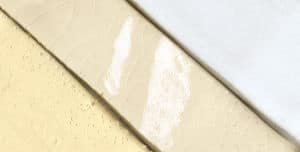Your cart is currently empty!
Can You Put Low Fire Glaze on High Fire Clay? Will it Work?
Published:
Last Updated:
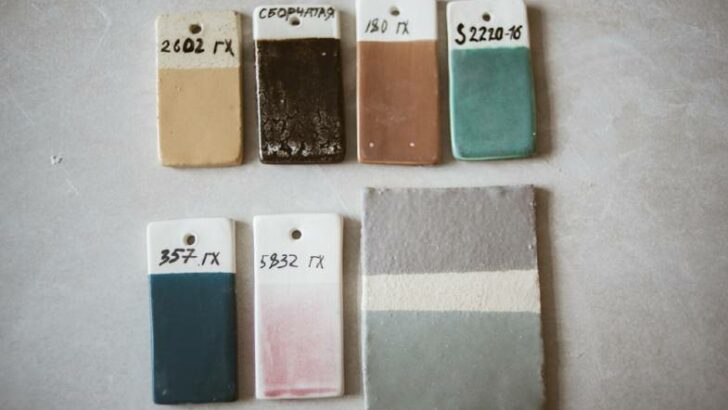
Affiliate Disclaimer
As an affiliate, we may earn a commission from qualifying purchases. We get commissions for purchases made through links on this website from Amazon and other third parties.
If you are learning about glazing, there is a lot to take on board. There is a large range of different glazes to choose from. And like clay, you can get low fire, mid fire, and high fire glazes. You may have been wondering if you can put low fire glaze on high fire clay. This article is all about what happens if you use earthenware glaze on stoneware clay.
Low fire glaze and mid or high fire clay mature at different temperatures. Stoneware clay fired at the right temperature for earthenware glaze will still be very porous. Also, low fire glaze shrinks more than stoneware clay when it cools. This can cause the glaze to crack and craze.
Therefore, when you use low fire glaze on high fire clay, your pottery won’t be suitable for functional use. Nevertheless, some potters do use earthenware glaze on stoneware, with some success. So, let’s take a closer look at some of the pros and cons of this practice….
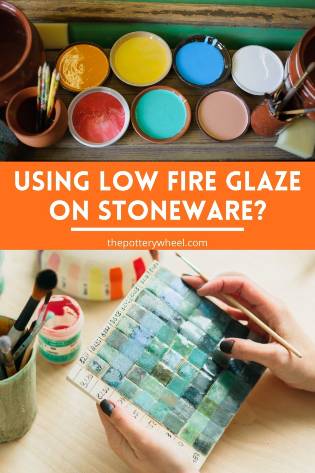
Low Fire Glaze on High Fire Clay – a Closer Look
Like clay, glaze matures when it is fired. And different clays and glazes mature at different temperatures. Low fire temperatures are often referred to as earthenware temperatures. And mid or high fire temperatures are often referred to as stoneware temperatures.
Low Fire Glaze on High Fire Clay – a Closer Look
Earthenware temperatures can range between 1479 and 2109F (804 and 1154C). This equates to the range of cone 015 to cone 1 on the pyrometric cone scale.
And stoneware temperatures are often divided into mid fire stoneware and high fire stoneware. Mid fire stoneware temperatures range from around 2134-2232F (1186-1222C). This is between the cone 4-6 range.
And high fire stoneware temperatures range from 2305-2381F (1263-1305C). This is the cone 8-10 range.
| Clay Body | Temp in F | Temp in C | Cone |
| Earthenware | 1479-2109 | 804-1154 | 015-1 |
| Mid Stoneware | 2134-2232 | 1186-1222 | 4-6 |
| High Stoneware | 2305-2381 | 1263-1305 | 8-10 |
Pottery suppliers will make life easy for you and will label your clay or glaze clearly. The bag that your clay is packaged in will specify the temperature range that the clay can be fired at. And the glaze packaging will usually advise you exactly what cone to fire to.
A low fire glaze will for example specify that the glaze should be fired to cone 06.
Using Earthenware Glaze on Stoneware Clay – Can it Work?
There are circumstances when potters use low fire glaze on stoneware. Schools are a good example of where this practice is not uncommon. Stoneware clay is generally a little easier to use than earthenware. So, it’s a good option when you are learning to make pottery.
However, a school may not want to fire up to stoneware temperatures.
As a result, it’s not unusual for school art rooms to supply students with cone 6 stoneware clay. And glaze fire the pottery to cone 06, using low fire glazes.
Hobby potters learning to make pottery at home may also experiment with this practice.
Logically it makes sense to think that applying low fire glaze to high fire clay would be fine. After all, if you are firing to earthenware temperatures, the glaze will mature. And the clay won’t be over-fired. So, everything should be fine, right?
Well, the answer to that question, is, like many things in pottery and ceramics, ‘yes and no’.
Using Low Fire Glaze on High Fire Clay – What Can Go Wrong?
Different clay bodies mature at different temperatures. Clays are said to be mature when they have undergone either sintering or vitrification when they are fired.
Sintering
Sintering happens during the bisque fire. As the clay heats up when it’s fired, the clay particles move closer together and stick to one another. Because the particles weld to one another, the clay is rigid ceramic once it has cooled, rather than workable clay. The clay also becomes denser during sintering. Although the clay is denser, sintered ceramics are still porous. This is the process whereby pottery changes from being soluble clay to hard, insoluble ceramic.
Earthenware and stoneware clay both undergo the process of sintering when they are being bisque fired.
Vitrification
During the firing process, the heated clay also produces glass. In its heated liquid state, the glass fills up the spaces between the clay particles.
When the fired clay cools the glass solidifies. It is this solidified glass between the clay particles that make clay waterproof.
Earthenware clay produces only a small amount of glass when it is fired. Therefore, whilst a mature earthenware clay is sintered, it is not vitrified. By contrast, stoneware clay has more glass-forming properties. Therefore, when it is matured during firing, it is vitrified to the point of being waterproof.
Pottery that is used for functional purposes such as dinnerware, or water-holding vases needs to be vitrified.
Non-vitrified pottery will absorb water. If you put water into unglazed pottery that is not vitrified, the water will slowly seep into the ceramics. And eventually, it will seep through to the outer surface of the pottery.
Porosity
So, what does this mean for using earthenware glaze on stoneware clay? As the name suggests, low fire glazes are fired to earthenware temperatures. Stoneware clay does not mature at these temperatures.
At earthenware temperatures, there has been insufficient heatwork to activate the stoneware clay’s glass-forming properties. So, though the stoneware is sintered and has become ceramic, it is not fully mature and remains porous.
As a result, stoneware clay that has been fired at earthenware temperatures is not fully functional. This may not be a problem in the short term. For example, if you have glazed a stoneware mug with a low fire glaze, it may hold your coffee well.
However, when you wash the mug water will be absorbed into the unglazed areas of the pottery. If the bottom of the mug isn’t glazed, then water will be absorbed through the base.
With time, as the clay repeatedly absorbs water, this can weaken the structure of the pottery.
Also, if pottery has absorbed water and you then put it in the oven or microwave this can cause problems. The absorbed water expands and turns to steam and puts pressure on the structure of the ceramics.
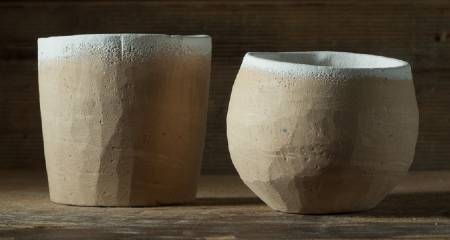
The heated water also creates very hot spots on the pottery making it uncomfortable if not dangerous to handle.
With time, the continual absorption of water will weaken the bond between the clay and glaze. The weakening of this bond allows for more water absorption and the pottery becomes even less functional.
Functional V’s Decorative Pottery
You might find that you use a low fire glaze on a high fire glaze and it looks fine. The combination of earthenware glaze on stoneware clay can sometimes look good.
Furthermore, because earthenware clay is low fire it remains porous even when it’s been glaze fired. This is because it does not vitrify. Therefore, you might reason that using porous non-vitrified stoneware fired at lower temperatures is no different from using earthenware clay.
The logic behind this argument makes sense. However, earthenware and stoneware clay contain different ingredients. And they behave differently when they are fired at lower temperatures.
Stoneware clay contains potassium and sodium oxides. These materials are fluxes and lower the melting point of the glass-forming ingredients in the clay and glaze. Fluxes promote liquefaction in the clay as it fires.
However, at the lower temperatures suitable for earthenware, stoneware particles simply fuse together. In fact, when fired to cone 04, stoneware is more porous than earthenware.
This is because until stoneware clay reaches around 2048F (1120C) the clay is expanding and porous. When it reaches this temperature, which is cone 02, the vitrification process begins. It is at this point that stoneware clay starts to densify.
By contrast, low fire earthenware clay contains other fluxes such as boron or magnesium. These substances promote the melting and densification of the clay at lower temperatures. Earthenware clay is always porous, even when fired to maturity. However, it is less porous and denser than stoneware fired to the same temperature.
What this means is that earthenware clay is more suited to low fire temperatures. The ceramics produced by low firing earthenware will be denser and less absorbent than low fired stoneware.
Glaze Fit
The other problem that most often arises from applying low fire glaze to high fire clay glaze ‘crazing’. Crazing is fine hairline cracks in the glaze. These may not be very apparent, and you may only notice them on close inspection.
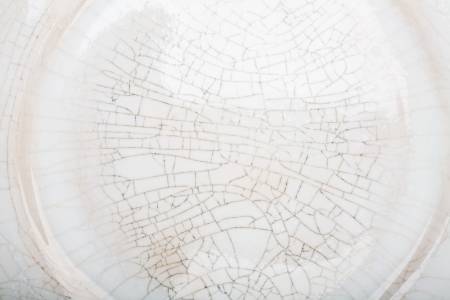
However, even if the crazing is not especially visible, it does cause problems. These problems are as follows:
- The glaze will not be watertight. Tiny cracks in the glaze will allow water to seep in, which will in time weaken the pottery.
- Crazing harbors microscopic bacteria, and as such is not food safe.
Crazing occurs when the glaze used has a different rate of thermal expansion to the clay it’s been applied to.
Thermal expansion refers to the amount that a substance expands or contracts when it is heated and cooled. Some materials expand and contract more than others. And similarly, some glazes expand and contract more than some clay bodies.
If a glaze and clay have the same rate of thermal expansion, they have a good ‘glaze fit’. This is because they expand and shrink at the same rate, without the glaze being put under too much pressure.
However, if the glaze expands and contracts more than the clay body, it will crack, if not immediately, then eventually. This is what causes crazing in glaze. And generally, low fire glazes do shrink at different rates to high fire clay bodies.
Ceramics that are used as functional ware are often heated up and cooled down day-to-day. Dinnerware will expand a tiny amount when it’s washed in hot water, or use in the oven. So, with time, a glaze that does not fit the clay body will crack.
Final Thoughts
A low fire glaze on a high fire clay may look fine to the naked eye. However, at a microscopic level, problems will be brewing if you use a combination of earthenware glaze on stoneware clay. If your ceramics are intended for decorative purposes only, this is not necessarily a problem. In fact, crazing can be quite an attractive design feature. However, for functional ware, using clay and glaze that fit one another is important.

